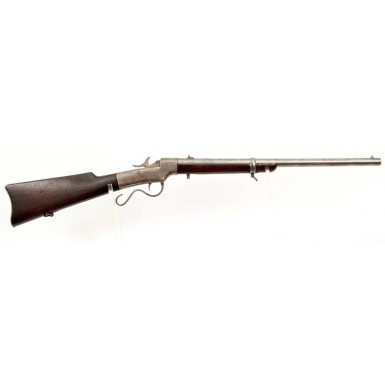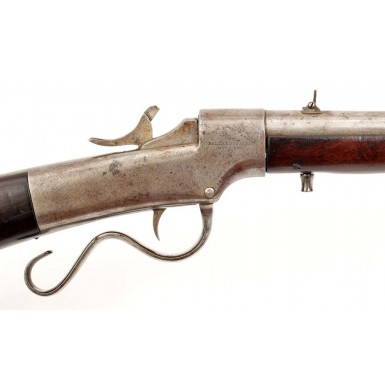Ballard 56-56 US Military Carbine - VERY SCARCE
- Product Code: FLA-2160-SOLD
- Availability: Out Of Stock
-
$1.00
This is a VERY GOOD condition example of an extremely scarce variant of the Ballard Carbine, a secondary US martial carbine from the Civil War era, which is most often encountered without military inspection marks of any kind. The Ballard Carbine was a breech loading, metallic cartridge breechloader that was invented by Charles H Ballard of Worchester, Massachusetts. His invention was issued US Patent #33631 in November of 1861. As Ballard was an inventor and not a manufacturer, he sought a way to market and sell his invention with an eye towards collecting patent royalties, instead of investing in a manufacturing facility to produce his guns. This lead to a partnership with the New York sales agents Merwin & Bray, who represented Ballard’s invention, received contracts for his guns, and then subcontracted the production of the guns to other established arms makers. With the Civil War well under way in the winter of 1861-1862, Merwin & Bray found a ready market for the well designed, single shot rim fire carbines and rifles covered under Ballard’s patent. They then negotiated the manufacturing contracts with Ball & Williams of Worchester, MA and Dwight, Chapin & Co. of Bridgeport, CT. After the conclusion of the Civil War three other makers produced arms under Ballard’s patents, but they are not relevant to this discussion. Between 1862 and 1865 Ball & Williams produced some 15,600 “small bore” carbines and rifles under Ballard’s patent. Of this production about 5,000 were sporting rifles in a variety of calibers, about 4,000 were military rifles (in both .44 and .46 rim fire) and the balance of 6,600 guns were military style carbines in .44rf. The majority of the 6,600 carbines were eventually delivered to the State of Kentucky for use by their cavalry. The US Ordnance Department contracted for 5,000 of the carbines in January of 1864, but only 1,509 of the guns were delivered, accepted and marked with Ordnance Department acceptance marks. The Ordnance Department rejected 600 additional carbines that were delivered for inspection, and Ball & Williams forfeited the balance of their US government contract in order to deliver the guns to the State of Kentucky at a higher price! The majority of the 1,509 US accepted guns (about 1,200) were sent to arm the Vermont State Militia, following the Confederate raid on St. Albans, VT on October 19, 1864. Nearly all of the remaining carbines produced were sold to the state of Kentucky, with an additional 500 being sold to the state of New York. Ballard military carbines were issued, to and saw service with the 3rd, 6th, 8th, 11th, 12th & 13th Kentucky Cavalry (US), as well as the 4th Kentucky Mounted Infantry. The carbines also saw some service with the 2nd Iowa Cavalry and 7th Ohio Cavalry. However, a much rarer martial variant of the Ballard carbine exists. The firm of Dwight, Chapin & Company of Bridgeport, CT, produced these very scarce guns. In the fall of 1862, Merwin & Bray received a contact from the US Government for 1,000 Ballard patent rifles and 1,000 Ballard patent carbines. Unlike the arms being produced by Ball & Williams, these guns were to be manufactured in a larger caliber, 56-56 Ballard. This was the same cartridge, with a different name, as the currently issued 56-56 Spencer (sometimes called 56-52). Ball & Williams were overloaded with their contracts for .44 and .46 Ballards, and could not take on any more orders. As a result, Merwin & Bray contracted with Dwight, Chapin & Company to produced the guns. According to most sources, Dwight, Chapin & Company delivered only 115 of the 56-56 Ballard carbines by September of 1863, and the company subsequently failed. At this time, Ball & Williams bought both the finished and unfinished guns and parts at auction, and proceeded to try to complete the contract. Most sources note that they managed to assemble an additional 1,000 carbines and 635 rifles in 56-56 Ballard, and most sources note that all by 35 of the rifles ended up being sold to the State of Kentucky. The guns finished by Ball & Williams are only marked with the Merwin & Bray and Ballard patent marks, and do not bear any Ball & Williams markings. Additionally, the guns and receivers that originally had Dwight, Chapin & Co markings had those marking removed prior to their sale by Ball & Williams. It appears, however, that at least a few of the carbines that were finished by Ball & Williams and delivered to the US military, as this example bears US military inspector cartouches, but is serial numbered 607, well past the 115 carbine deliveries that are noted in most references. The Ballard Carbine, in its primary Civil War configuration, was a single shot, breech loading, .44 RF (.44-33-250) carbine with a 22” octagon to round barrel. The Dwight, Chapin & Co produced examples were chambered in 56-56 and had a 20” fully round barrel. The gun used a simple dropping block action that was actuated by a combination triggerguard/under lever. While most cavalry carbines of the era were produced with a sling bar and ring, most Ballards were manufactured with a pair of sling swivels, one on the single barrel band and one in the toe of the buttstock. Some carbines had a third swivel on the reverse of the buttstock as well. The guns had a simple manual extractor system to remove the spent cases. Pulling a small, spring-loaded lever located under the gun to the rear, actuated the extractor. The US Ordnance Department started to sell off the obsolete carbines within months of the end of the war. The first of the federally purchased Ballard carbines to be offered for sale were 67 guns in inventory at the Allegheny Arsenal. The guns were offered at public auction on January 18, 1866 with a reserve price of $3.00 each, and did not sell. However, more than 400 Ballards were sold from the St. Louis Arsenal in April of 1869 for between .75” and $3.00 each. In October of 1871, Kentucky sent many of their state owned Ballard carbines to the New York Agency, where they were categorized as “100 “ New, 996 - Cleaned & Repaired and 645 - Unserviceable.” In October of 1882, the firm of Schuyler, Hartley & Graham purchased over 1,600 surplus Ballard carbines from the US Government at prices that ranged from $1.50 each to $4.00 each. In 1901, there were still some 495 Ballard .44 carbines in inventory at the New York Agency, and in June of that year they were sold to Marcus Hartley & Co. for .86” each. Interestingly, Hartley owned a large chain of sporting goods stores and had purchased the Remington Arms Company in 1886.
This example of the Ballard 56-56RF Carbine is in VERY GOOD condition. The gun is complete, correct and fully functional. The gun is clearly marked in two horizontal lines on the upper right side of the receiver: BALLARD’s PATENT / NOV. 5, 1861. The opposite side of the receiver is marked: MERWIN & BRAY AGT’s / NEW YORK / 607. As is typical of Dwight, Chapin & Company 56-56 Ballards that were assembled by Ball & Williams, the gun bears the markings of neither company. The gun is the correct round-frame design with a round 20” barrel and a split breechblock. The breechblock is assembly numbered 73 on each side, and also has a single 1 on each side, upside down from the “73” marking. Unlike the Ball & Williams produced guns (versus Ball & Williams “assembled” guns), this carbine does not have a serial number on the major components like the extractor, hammer, etc. The gun does, however, bear a pair of US military inspector cartouches. One is located on the wrist and one is on the comb of the stock, directly in front of the buttplate tang. They both appear to be a script JM, and I am not sure which inspector they reference. As previously noted, the gun is in VERY GOOD condition. The metal is smooth throughout, with only the smallest scattered patches of light peppering and pinpricking and some tiny specks of lightly oxidized roughness. The gun retains none of its original blued finish, but has a smooth pewter gray patina, mixed with scattered patches of lightly oxidized freckling and age discoloration. This patina is evenly distributed over the barrel, frame and breechblock. The hammer and operating lever appear to retain small traces of their original finish, mixed with the same smooth gray patina and light freckling. The carbine functions exactly as it should and is mechanically excellent. The breechblock moves freely when operated and locks tightly into place, as it should. The small closure stud that secures the operating lever at the rear of the trigger tang is broken, as is often the case with Ballard carbines and rifles. As a result, the lever does not lock into the closed position. This is a minor inconvenience. The hammer functions correctly, and automatically assumes the half-cock position when the breechblock is opened. The hammer locks crisply into the full-cock notch as well, and responds to the trigger, as it should. The extractor system of the carbine is complete and fully functional, and the spring remains extremely strong. The original L-shaped, two-leaf rear sight is present on the top of the receiver. It retains some traces of its original blued finish and is clearly marked with the 200 YDS and 300 YDS graduations. The slight is fully functional and rotates into its two positions, as it should. The original front sight, near the muzzle, is present as well. The gun also retains both sling swivels. The bore of the carbine rates VERY GOOD in condition. It is mostly bright and shiny, with extremely crisp 5-groove rifling. The bores shows scattered patches of light to moderate pitting along its length, mostly in the grooves. The stock of the carbine rates about NEAR FINE. The stock retains very crisp edges and sharp lines, showing no signs of sanding. The buttstock does have a couple of small surface cracks along the lower portion of the reverse side. These are minor and the result of drying wood. They are tight and stable and in no way structural. The buttstock and forend are complete and solid and are free of any breaks or repairs, but do show some of the usual scattered bumps, dings and rubs that one would expect from a military carbine which saw actual service and use. The stock has a lovely reddish-brown tone and appears to retain much of its original oil finish. A small cross or “X” is lightly carved in the obverse buttstock, and may have been a bit of personalization from the soldier who carried the carbine. As noted above, a pair of very nice script JM inspection cartouches are present on the carbine, one on reverse wrist and one on the stock comb.
Overall this is a very crisp and attractive example of an extremely scarce US military secondary issue breech loading carbine. Most references confirm 115 guns delivered by Dwight, Chapin& Company, and suggest that a few more may have been accepted after Ball & Williams took over the contract. This appears to be one of those handful of very rare guns that was accepted by the US military after the failure of Dwight, Chapin & Co. The gun is complete and fully functional and displays wonderfully. You certainly don’t need any imagination to see the inspection cartouches, as they are clearly visible at a distance. This is one of those very rarely encountered US military carbines that is missing from practically every advanced Civil War carbine collections, and it would be a wonderful addition to your collection.
SOLD








